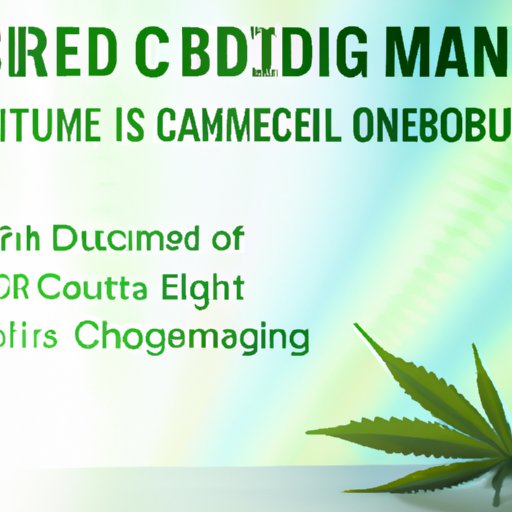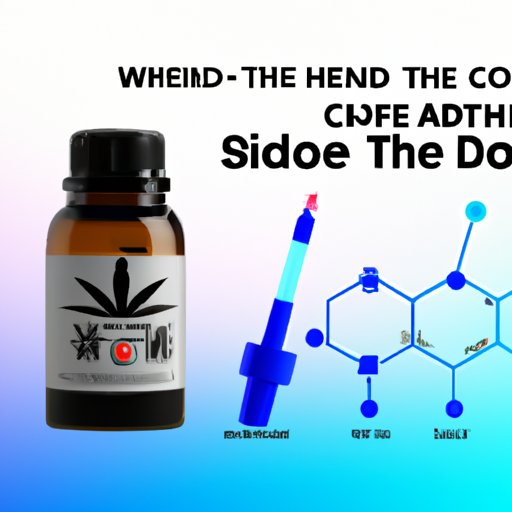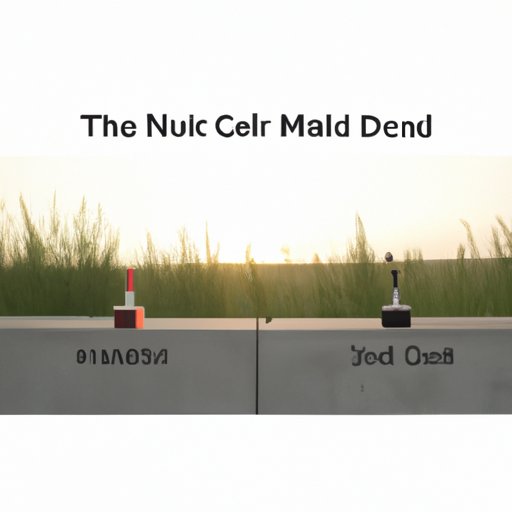Introduction
Cannabidiol (CBD) is a non-intoxicating component of the cannabis plant, which has been shown to have potential therapeutic benefits for a range of conditions, from pain relief to anxiety reduction. CBD is available in various forms, including oils, capsules, edibles, and topicals.
One of the most common concerns for people starting on CBD is how to determine the correct dosage. Some may be afraid of taking too much, while others may feel discouraged by the lack of clear guidance or standardized dosages from manufacturers.
This article aims to guide you through the key factors to consider when deciding on your ideal CBD dosage so that you can reap the benefits of this natural compound without the uncertainty.
A Beginner’s Guide to CBD Dosage: How Much CBD Should You Take?
Before we delve into the specifics of how to calculate your ideal CBD dosage, it’s essential to understand the factors that can influence your dosage needs. These include:
The Factors Affecting CBD Dosage
Your body weight: Generally, the heavier you are, the more CBD you will need to experience the same effects. This is because CBD needs to be metabolized and dispersed throughout your body, and larger bodies require higher doses for optimal results.
Your tolerance level: If you are new to CBD, you will likely need less than someone who has been using it regularly for a while. Likewise, your tolerance level can increase with time, so you may need to adjust your dosage accordingly.
The concentration of the CBD product: Different CBD products have varying concentrations of CBD per milliliter (ml), ranging from 100mg/ml to 5000mg/ml or more. Products with higher concentrations require smaller doses to achieve the desired effect.
Your individual health needs: The benefits of CBD can vary depending on the condition you are trying to alleviate, the severity of your symptoms, and your overall health status. Some people may find relief with a low dose, while others may need a higher amount.
Common Starting Dosages and How to Adjust Them
When starting with CBD, it’s always best to begin with the lowest possible dose and gradually increase it until you achieve the desired results. This approach allows you to identify any adverse reactions or side effects and adjust your dosage accordingly.
Most CBD products provide recommendations for their use on the label, such as a suggested serving size or number of drops. However, the recommended dosage should be taken as a guideline rather than a strict rule. Your individual needs and tolerance may require a different dosage.
A common starting dose for CBD is 5mg to 10mg per day. This can be increased gradually in increments of 5mg every few days until the desired effect is achieved. For example, if you started with 5mg and didn’t feel any relief after a few days, you could increase your dosage to 10mg and see if that makes a difference.
It’s important to note that it can take some time for CBD to build up in your system and produce noticeable effects. Some people may need to take CBD for several weeks before they experience the full benefits.
Risks of Taking Too Much CBD
While there is no known lethal dose of CBD, taking too much can lead to unwanted side effects such as drowsiness, dizziness, dry mouth, and diarrhea. It’s important to follow the recommended dosage guidelines and not exceed them without consulting with a healthcare provider.
In addition, taking too much CBD can also lead to a tolerance buildup, making it less effective over time. This is why it’s essential to find your optimal dosage rather than taking more in the hopes of achieving better results.

The Science Behind CBD Dosing: Understanding Milligrams and Their Effect on the Body
To understand the science of CBD dosing, it’s helpful to have a basic knowledge of the endocannabinoid system (ECS), the complex network of receptors and neurotransmitters that regulates various bodily functions such as sleep, mood, appetite, and pain sensation.
The Endocannabinoid System
The ECS has two primary types of receptors: CB1, which are primarily found in the brain and central nervous system, and CB2, which are more prevalent in the immune system and peripheral tissues. When you ingest CBD, it interacts with these receptors to produce various effects.
Specifically, CBD is thought to inhibit the breakdown of anandamide, an endocannabinoid that helps regulate pain and mood. By increasing the levels of anandamide, CBD can enhance its effects and promote a sense of calm and relaxation.
CBD Absorption and Metabolism
When you consume CBD, it goes through a process called first-pass metabolism, where it is broken down by enzymes in the liver and digestive system. Only a fraction of the original dose reaches the bloodstream, where it can interact with the ECS.
The bioavailability of CBD, or the amount that actually enters the bloodstream, depends on several factors, including the method of consumption, the dose, and individual physiological factors such as metabolism and overall health.
For example, vaping or smoking CBD products can provide faster and more potent effects since the CBD bypasses the digestive system and enters the lungs directly. However, these methods can also be harsh on the lungs and may not be suitable for everyone.
The Effectiveness of Different Dosages
The effectiveness of a CBD dosage depends on several factors, including the individual’s ECS, the concentration of CBD in the product, and the method of consumption.
A 2019 study published in the Journal of Clinical Medicine found that doses of 300mg to 600mg of CBD per day were effective in alleviating anxiety and sleep disorders in adults. However, further research is needed to determine the optimal dosage for specific conditions and individuals.

Finding Your Sweet Spot: Tips for Determining the Ideal CBD Dosage for You
The ideal CBD dosage varies from person to person and depends on several factors such as body weight, health condition, and tolerance level. Here are some tips for finding your sweet spot:
Keeping a Dosing Journal
A dosing journal can help you track your CBD intake and the effects it has on your body. Record the date, time, dosage, method of consumption, and any notable effects or side effects you experience. Over time, this record can help you identify patterns and adjust your dosage as needed.
Trying Different Dosages and Methods of Consumption
Experimenting with different doses and consumption methods is the best way to find your ideal CBD dosage. Start with a low dose and gradually increase it every few days until you achieve the desired effect. You can also try different methods of consumption such as vaping, edibles, or topical applications to see which works best for you.
Consulting with Medical Professionals
If you have a medical condition or are taking medications, it’s essential to consult with a healthcare provider before starting on CBD. They can provide personalized guidance on dosage and potential interactions with other medications.
Overcoming Misconceptions: Debunking Myths About CBD Dosage and Safety
There are several misconceptions about CBD dosage and safety, which can make it difficult for beginners to navigate the CBD market. Here are some common myths and misconceptions:
The Differences Between CBD and THC
Many people confuse CBD with tetrahydrocannabinol (THC), the psychoactive compound in cannabis that produces a ‘high’. However, CBD is non-intoxicating and does not produce the same psychoactive effects as THC. This makes it a safer and more approachable option for many people.
The Lack of Federal Regulation and Standardization
Since CBD is a relatively new and unregulated industry, some products may not contain the labeled amount of CBD, or may contain harmful contaminants. This is why it’s important to research the brand and product before purchasing and to look for third-party lab results. These reports can confirm the potency and purity of the CBD product.
The Risks of Using Low-quality or Mislabeled CBD Products
Using low-quality or mislabeled CBD products can lead to unwanted side effects and may not provide the desired health benefits. Always look for products that are legally sourced and tested for purity and potency. If in doubt, consult with a healthcare provider or CBD expert for recommendations.
A Step-by-Step Guide to Calculating Your Ideal CBD Dosage
Understanding Concentration Levels
The concentration of CBD in a product is measured in milligrams (mg) per milliliter (ml). For example, a 30ml bottle of CBD oil with a concentration of 1000mg/ml contains 30,000mg of CBD in total.
Calculating Dosage Based on Body Weight
A common formula for calculating CBD dosage is to take 1-6mg of CBD per 10 pounds of body weight. This means that if you weigh 150 pounds, a 15-90mg dose may be appropriate for you. However, this formula should be taken as a guideline only, and individual needs may vary.
Adjusting Dosage Based on Personal Factors
When determining the optimal CBD dosage, it’s essential to consider individual factors such as your individual health needs, tolerance level, and method of consumption. Start with a low dose and gradually increase it until you achieve the desired effect.
Navigating the World of CBD Products: Understanding Labels, Concentrations, and Serving Sizes
Types of CBD Products
CBD is available in various forms such as oils, capsules, edibles, and topicals. Each type of product has its unique benefits and drawbacks, so it’s important to choose the one that suits your needs and preferences.
Reading Product Labels
When purchasing CBD products, it’s important to read the label carefully to understand the concentration of CBD per serving or per ml, the ingredients, and the manufacturer’s recommendations for use.
Understanding the Differences Between Serving Sizes and Dosages
Serving sizes and dosages can be confusing and may differ between brands and products. A serving size refers to how much of the product you consume at one time, while the dosage refers to the amount of CBD contained in each serving. For example, a 30ml bottle of CBD oil with a serving size of 1ml may contain 100mg of CBD per serving.
Conclusion
Overall, finding your ideal CBD dosage requires some experimentation and patience. Begin with a low dose, keep a dosing journal, and adjust your dosage gradually until you achieve the desired effect. Remember to choose high-quality CBD products, read the product label carefully, and consult with a healthcare provider if necessary. With these tips, you can reap the benefits of CBD with confidence.
